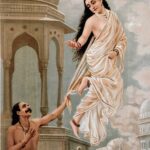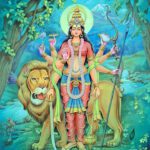Ushas is a significant figure in Hindu mythology, representing the dawn and the light that breaks the darkness of night. She is often depicted as a beautiful woman who brings the first light of day, symbolizing hope, renewal, and the promise of a new beginning. In the ancient texts, Ushas is associated with the Vedas, which are the oldest sacred scriptures of Hinduism. Her role is not just limited to the physical act of dawn but also extends to various philosophical and spiritual interpretations.
The Role of Ushas in Vedic Literature
In the Rigveda, one of the oldest texts in the world, Ushas is mentioned numerous times. She is described as a goddess who rides in a chariot drawn by red horses, illuminating the sky with her radiant presence. The hymns dedicated to her often express gratitude for the light she brings, which dispels the darkness of ignorance and evil. Ushas is not just a goddess of light; she is also seen as a harbinger of knowledge and truth.
 Urvashi
UrvashiMany Vedic hymns celebrate Ushas as a benevolent force. They depict her as a nurturing mother who brings forth life and sustenance. The recurring theme in these hymns is the transition from darkness to light, symbolizing the victory of good over evil. Ushas is often invoked in rituals and prayers, signifying her importance in daily life and spiritual practices of the ancient Indians. The Vedic poets personified her as a gentle and compassionate deity, who listened to the prayers of her devotees.
Symbolism of Ushas
Ushas is rich in symbolism, representing various aspects of life and the universe. Her emergence at dawn signifies the end of ignorance and the beginning of knowledge. She embodies the idea of renewal and rebirth, reminding us that every day is a new opportunity to seek enlightenment. In many cultures, dawn is a time for reflection and setting intentions, and Ushas encapsulates this sentiment perfectly.
In a broader sense, Ushas symbolizes the duality of light and darkness. While she brings light, she also reminds us of the existence of darkness. This duality is essential in understanding the nature of life, where light and dark coexist. In Hindu philosophy, this can be related to the concepts of dharma (righteousness) and adharma (unrighteousness), emphasizing the importance of choosing the path of light in our lives.
 Upanishads
UpanishadsUshas in Art and Iconography
Ushas has been depicted in various forms of art and iconography throughout history. In sculptures and paintings, she is often portrayed as a beautiful woman with flowing hair, wearing a luminous dress. The imagery of her riding a chariot drawn by horses is a common theme, symbolizing her swift arrival at dawn. Artists often use vibrant colors to depict her, representing the golden hues of sunrise.
In some representations, Ushas is shown with a lotus, a symbol of purity and beauty. This connection to the lotus further emphasizes her role as a goddess who brings forth new beginnings. Temples dedicated to Ushas often feature intricate carvings and murals that narrate her stories and attributes, making her an enduring figure in Hindu art and culture.
Ushas and Other Deities
Ushas is often mentioned alongside other deities in Hindu mythology, creating a rich tapestry of interrelated stories and themes. One of her most notable companions is Surya, the sun god. Together, they represent the cycle of day and night, where Ushas heralds the arrival of Surya, who brings full light to the world. This relationship highlights the importance of collaboration and harmony among the deities.
 Uma
UmaAdditionally, Ushas is sometimes associated with Agni, the fire god. In Vedic texts, Agni is seen as the mediator between the gods and humans, while Ushas represents the awakening of consciousness. Their connection signifies the role of light in igniting passion, creativity, and spiritual awakening. The interplay between these deities illustrates the complexity of Hindu mythology, where each figure has a unique role yet contributes to a larger narrative.
Festivals and Celebrations
Ushas is celebrated in various festivals across India, particularly during the Usha Arati, a ritual performed at dawn to honor her. Devotees gather to chant hymns and offer prayers, expressing gratitude for the light she brings into their lives. This ritual emphasizes the significance of starting the day with positive intentions and spiritual focus.
- Usha Arati: A dawn ritual honoring Ushas.
- Chaitra Navratri: Celebrated in spring, honoring various goddesses, including Ushas.
- Diwali: The festival of lights, symbolizing the victory of light over darkness.
During these festivals, various cultural activities take place, including music, dance, and storytelling, all aimed at celebrating the essence of Ushas. These celebrations not only honor the goddess but also serve as a reminder of the importance of light and knowledge in overcoming life’s challenges.
The Philosophical Significance of Ushas
Beyond her representation as a goddess, Ushas holds deep philosophical significance in Hindu thought. She embodies the concept of enlightenment, urging individuals to seek knowledge and truth. The dawn symbolizes the awakening of the mind and spirit, encouraging people to rise above ignorance and embrace the light of understanding.
In many philosophical texts, the transition from night to dawn is used as a metaphor for the journey of life. Just as the sun rises after the darkest night, individuals can overcome their struggles and emerge into the light of awareness and wisdom. Ushas serves as a reminder that challenges are a part of life, but they can lead to growth and transformation.
Modern Interpretations of Ushas
In contemporary times, Ushas continues to inspire various interpretations and adaptations. Artists, writers, and spiritual leaders often draw upon her symbolism to convey messages of hope and renewal. In literature, Ushas is sometimes portrayed as a metaphor for new beginnings, encouraging readers to embrace change and the unknown.
In popular culture, Ushas can be found in films, music, and art, where her essence is reimagined to resonate with modern audiences. This ongoing relevance highlights the timeless nature of her character and the universal themes she represents. By connecting with Ushas, individuals can find inspiration to navigate their own journeys and seek the light in their lives.
Ushas remains a pivotal figure in Hindu mythology, embodying the essence of dawn, renewal, and enlightenment. Her presence in ancient texts, art, and modern interpretations showcases her enduring significance in the cultural and spiritual landscape of India. As a goddess who brings light to the world, Ushas invites us to reflect on our own paths and the choices we make as we move from darkness into the light.
